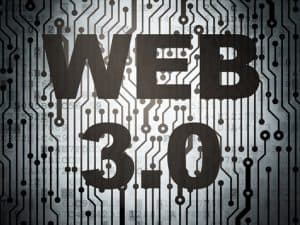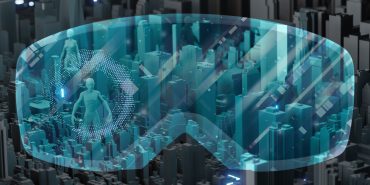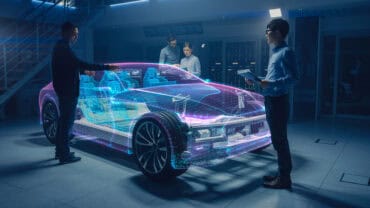
At its core, Web 3.0 is attempting to empower organizations and individuals by getting rid of centralization and intermediaries.
The past few decades have been incredible. The Internet provided inexpensive global connectivity as the underlying backbone of digitization. The Web offered robust, convenient navigation for information of all kinds: text, image, video, or any media. And voila`– with this universal connectivity and hypermedia – we have the computing platform that revolutionized society.
How is the Web evolving, and what will it be in its future?

The Web 1.0 was essentially read-only. Organizations started to create content and connect them via the HTML hyperlinks: click on the underlined (mostly) blue link, and it will take you to a different document or Web page.

Web 2.0 saw the emergence of Web applications and the consumer’s ability to generate content via Social Media. Web 2.0 became richer in media (especially Video) and more dynamic in content creation, communication, and perhaps most importantly, evaluations captured in Social media following and “likes.” The major Big Tech companies such as Amazon, Apple, Facebook, Google, Twitter, and other emerging Social networking platforms own most of the content sharing, interaction, and participation on the Internet. Through primarily pushing advertising and content ranking, the Web has become a formidable money-machine. The source of the money? You! Our choices, our interactions, our preferences. In other words, our Data! The Web has become a very centralized (controlled by few Big Tech companies) and financially motivated milieu par excellence!
This brings us to Web 3.0.
As we shall see, there are different perspectives on the future of the Web.
Which perspective will dominate and emerge as the pervasive
trend? Will we have a hybrid? Will we see the emergence of an entirely
different paradigm?
Download Now: Building Real-time Location Applications on Massive Datasets
Web 3.0: Decentralization and the Stateful Web
If you have ever done any development or research in Blockchain, you would inevitably run into Web 3.0 (though sometimes called “Web3”). It is hyped as the next iteration of the Web – post Web 1.0 and Web 2.0 – that makes the Web decentralized. Sometimes the blockchain-enabled Web 3.0 is characterized as the stateful Web. The stateful Web involves awareness between peers, and it is core to the decentralized peer-to-peer exchanges. Please read it as the decentralized Web.
At its core, Web 3.0 is attempting to empower organizations and individuals by getting rid of centralization and intermediaries: You can own your data and monetize it. You also can conduct business, network, and interact with your peers without an intermediary. Directly peer-to-peer!
The Web 3.0 decentralization is founded upon Blockchains. What are Blockchains? Well, they are an aggregate of rather dull technologies. A Blockchain is a cryptographically secured ledger of transactions organized in blocks. It is not owned or stored in a central repository or data center. It is replicated, distributed, and decentralized across many servers – that are called “nodes.” That’s it!

The following illustrates the Decentralized architecture of Blockchain: you can have nodes that “validate” the content of the Blockchain and those that can only generate or read “transaction.” What is a transaction? It is an entry in the ledger: e.g., John sent a Bitcoin to Marry on March 5. A “block” in a Blockchain is a group of validated transactions.
What about the aggregate of technologies in Web 3.0? The following high-level illustration from Blockchain 101 is quite good as it attempts to provide a stack analogous to the OSI 7 layer model.

The Web 3.0 decentralized architecture involved nodes that operated peer-to-peer, updating a chain of blocks. There are complex “consensus” algorithms (think of it as the single version of the truth as the Blockchain is replicated on the participating validating nodes). In addition to the peer-to-peer decentralized and disintermediated recording of transactions, Blockchains also execute Smart Contracts. Smart contracts are the rules and mutual agreements between parties that get implemented in the Blockchain. For more details – in addition to the Blockchain 101 article – check Blockchain Decentralization and the references therein.
This decentralized network of nodes is attempting to revolutionize the Internet: Web 3.0!
Web 3.0 Internet of Value
There is also a companion perspective on Blockchain about the next generation of the Internet. Blockchain is very much a revolution. It is the engine that empowers the emergence of the Internet of Value. Ripple’s description of the Internet of Value is quite good: “value to be exchanged as quickly as information.” The exchange of value speed has tremendous implications in many applications: for consumers, industries, and governments. It is not just monetary value.
So we have the Internet of Information (the more traditional Internet – the one we use every day searching for information), the Internet of Things or connected devices that are becoming pervasive, and now the Internet of Value. Through peer-to-peer transactions without intermediaries, Blockchain technology allows individuals and organizations to easily exchange digital money and execute business contracts between trading partners. The following on the economic value of the Blockchain captures the essence of the Internet of Value: “The Blockchain and associated technological changes will massively disrupt current economic conditions. The industrial revolution ushered in a world where business models were predicated on hierarchy and financial capitalism. The blockchain revolution will see an economy dominated by human capitalism and greater individual autonomy.”
Web 3.0: The Semantic Web
If you go back a few years, you also run into Web 3.0 in a slightly different context. The Web 3.0 is Tim Berners-Lee‘s vision of the Web’s evolution. This too is touted as the next generation of the Web but more from understanding the Web’s meaning (aka semantics) than mere hyperlinking content or Web pages. As you recall, Berners-Lee is the inventor of the World Wide Web. Web 3.0 in this vision is characterized as the semantic Web. This different vision at its core is about enriching the experience on the Web through more intelligent navigation. Here is a description of the evolution from Web 1.0 to Web 3.0 – primarily from the semantic net perspective:

The concept of a semantic (aka “meaning” vs. pure hyperlinking or syntax) annotation of the Web makes sense. Think of the World Wide Web as a collection of nodes. What are these? Well, Web sites, Web pages, images, videos, comments, tweets – you name it – are all nodes. Now, suppose we can augment or annotate these with meaning (aka semantics) in a standard way. In that case, it has the potential of greatly enhancing our experience with the Web: optimizing our navigation and search results.
The Semantic Web has its technology stack. RDF stands for Resource Description Framework. It is defined by the World Wide Web Consortium (W3C). It has an XML syntax that is much richer than mainly syntactic HTM. It adds semantics meta-data. To see one benefit of RDF enrichment of the Web, W3.org describes it as “Adding machine-readable information to Web pages using, for example, the popular schema.org vocabulary, enabling them to be displayed in an enhanced format on search engines or to be processed automatically by third-party applications.” The stack illustrates other technologies. One of the most notable of these is OWL – the Web Ontology Language for even richer (extending RDF) semantics and potential reasoning. If adopted in large numbers, the benefit of a Semantic Web is the richer and more precise experiences in especially navigating and searching the Web. There are other benefits.

The Universal Resource Identifier (URI) potentially can provide addressability to any resource on the Internet – including physical objects or connected devices. It is also interesting to note that the Digital Signature (sometimes you see it characterized as Cryptography) and Trust are core characteristics of Blockchains.
Now while the vision of adding richer semantics to the hyperlinks of the Web is compelling, the Semantic Web (Tim’s Web 3.0 vision) has lost steam. It is somewhat academic and not as popular as the decentralization perspective of Web 3.0.
The Future of The Web: The Tech Giants
Of course, we cannot also ignore the most influential players on the Web who also have a vision for the Web’s future. The so-called “Big Tech” giants such as Amazon, Twitter, Apple, Facebook, Google, and Microsoft have their say. Yes, it is about our (the user or consumer) monetization and complete domination and control of everything on the Web. It is a vision – but with different priorities.
The following illustrates the “Internet minute” and is updated every year. It is a good indicator of what is going on in the participatory and content creation engagements of society.

Source: https://www.allaccess.com/merge/archive/31294/infographic-what-happens-in-an-internet-minute
The Big Tech-enabled content creation and social interactions are dominating the Internet in this Web 2.0 era.
The HBR article from July 2020 provides some interesting stats: “Amazon controls a third of the cloud business, 44 percent of e-commerce, and a staggering 70 percent of the smart-speaker market. Google controls over 90 percent of searches. Facebook has become a conduit for political disinformation and Apple a symbol of conspicuous consumption and ruthless brand protection. As tens of thousands of small and not-so-small businesses face bankruptcy in the wake of the pandemic, all four companies continue to thrive.”
This essentially centralized and monetizing dominance will probably continue unabated in the foreseeable future. At least, that is what High Tech hopes for. To survive, publicly traded companies must show sustainable growth to Wall Street. Perfectly understandable.
The Big Tech is also innovating and pushing the Web’s future in new digital technologies and richer virtual and social networking experiences.
The Spatial Web 3.0

In addition to the Decentralization and Semantics perspectives, there have been serious attempts to combine these two and add robust spatial technologies to the Web. Here, the evolution of the Internet includes much richer experiences – especially through interactions with the user’s physical environment. It is the most impactful and user-centric approach of all.
Web 3.0 is primarily about emersion with this approach: especially through emerging technologies such as Augmented Reality and Virtual Reality. The trend here is very much an Internet of Things and AR/VR devices to coalesce the cyber-physical worlds and provide unique personalized and immersive experiences to the user.
The immersive experience with new technologies augmenting our physical environments is being promoted with all the Big Tech companies with their repertoire of devices. As a practical and straightforward example, Google Live View uses Artificial Intelligence to provide information, directions, points of interest – augmenting streets and buildings.
Which Web 3.0 is it? What Does it all mean?
To say the trends and predictions of the Web’s evolution are complex and confusing is the understatement of the decade! We know for sure the Web is evolving. Decentralization, Immersive experiences, and intelligence (aka AI or Knowledge) are exploding, and we know they both will play a central role in the next generation of the Web.

Can these trends – Decentralized, Semantic, and AR/VR immersive – be combined? There is an interesting book with the title The Spatial Web: How Web 3.0 Will Connect Humans, Machines, and AI to Transform the World that does precisely that. Here is how the authors define it: “The term ‘spatial’ in the Spatial Web references how our future interfaces enable a web that extends beyond the screen to integrate and embed spatial content and interactions, facilitated by distributed computing, decentralized data, ubiquitous intelligence and ambient, persistent, edge computing. Each of these technology trends fundamentally extends computing power further into space around us, bringing new dimensions of experience, connection, trust, and intelligence to the world.”
The Spatial Web Foundation also provides a high-level Web 3.0 stack with the Interface layer – with AR/VR and Internet of Things connectivity. The other two layers are the Cognitive / AI layer and decentralized Blockchain.
This exciting positioning shows the Web’s evolution for the three layers: Data, Logic, and Interface. Will this be the future of the Web: the spatial Web 3.0? Perhaps. But the reality – especially with the Big Tech not being sidesteps – will probably be a hybrid.
- Centralized – primarily through Big Tech – and Decentralised Web will co-exist for the foreseeable future: It will not be that easy to replace the giants. Remember, much of the infrastructure, such as under-ocean fiber optics cables, is funded by the Big Tech companies. Furthermore, the number of social media users and the maturity of these platforms will not be easy to disrupt. Imagining peer-to-peer networking and collecting tools for Social media and content sharing with Blockchain will disrupt the Big Tech is a bit naïve. Nevertheless, the compelling value proposition of Decentralization will continue to expand. Blockchain has entered the digital Web transformation, and its footprint is going to increase.

- Augmented and Virtual Reality will continue to make their way from games and entertainment to the mainstream. The immersive and personalized experiences are too compelling. Soon most of the Web interaction will be done through physical-cyber devices that will permeate our devices (will the mobile phone be obsolete?), our connected cars, our homes, our cities, and our places of work. Big Tech is playing a considerable role and funding the research and development of new technologies. Hopefully, the operation of these devices will not depend on the lower-level database and networking technologies. It thus will be able to operate with either or both technologies: centralized and Blockchain.
- Artificial Intelligence: The core of Web 3.0 will be AI. But that term is sometimes nebulous and can have many meanings. The original Semantic Web vision did not pan out as the Web’s future – namely Web 3.0. The standards such as RDF and OWL did not take off, and they did not augment HTML. Nevertheless, AI spanning facial recognition, self-driving cars, machine learning systems, and personalization significantly impact our experiences. AI is here to stay. Augmenting the WWW with sematic annotations might not even be necessary – given the advances to AI.
So, there you have—no clear choice from the three trends and the Big Tech dominance. Instead, a more complex and hybrid Web could be more potent than any of the single technologies or trends by themselves.





























